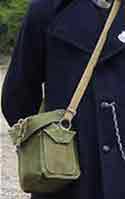Gas masks in World War Two Britain

In WW2, the British Government was concerned that the Germans would use poisonous gas as a weapon, as they had done in WW1. So every individual was issued with a mask, also known as a respirator, to protect against the gas. This page describes how the gas masks worked, how they were put on, the different types for adults, children, babies and the military, and the legal requirements for use. Practicalities and emotions are described through personal recollections.
____
By the webmaster: her early recollections with additional firsthand contributions
Gas mask or respirator?
Because of the fear of gas attack in World War Two, everyone in the UK was issued with a respirator which was a device to filter out poisonous gas. There were different types which included those for adults, children, babies and specialist personnel. In all, 38 million were distributed.
At the time everyone referred to these devices as gas masks. Now, in the twenty first century, with the World War very much in the past, everyone knows what a respirator is and only those alive during the war would even remember the term gas mask. This website, however, records the experiences of the past, as described by people who were there at the time, and it would be wrong to do a major edit of people's descriptions. So, in the spirit of the website and to maintain accuracy, this page retains the old term of gas mask rather than respirator.
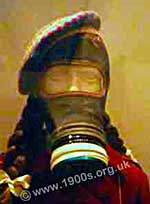
An adult gas mask on a model*
How gas masks worked
Gas masks were made of rubber to fit closely round the face with a perspex viewer for the eyes. When the wearer breathed in, air was sucked through a charcoal filter which removed the poison gas.
Expelled air forced the mask away from the face briefly, only for it to return for breathing in through the filter. Children's gas masks had a type of one-way valve to let out the expelled breath, but I don't know which, if any, other gas masks had anything similar. If you know, please contact me.
How gas masks worked is explained well through pictures. The following are from cigarette cards.
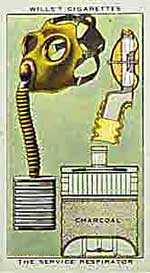
Gas masks for soldiers**
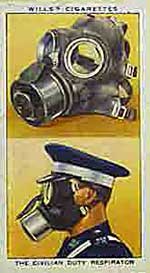
Gas mask for civilians on duty*
The first of this pair of pictures shows an enlargement of the charcoal filter arrangement. This gas mask was actually for members of the forces because it had larger charcoal filters than regular adult gas masks so that the wearers could work for longer in the poison gas. Nevertheless the principle was the same for the other types of gas mask.
The other picture is better at showing the strap arrangement which held the gas mask in place.
How to put on a gas mask
The gas mask had to be correctly fitted and adjusted in order that the user could breathe clean air, free from poison gas. So it was crucially important that the mask was tried on as soon as it arrived and the straps properly adjusted for a perfect fit.
The cigarette card image shows the stages involved.
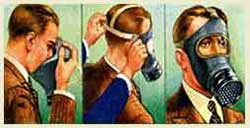
How to put on a gas mask
Children taught how to put on gas masks
contributed by Peter Johnson, personal recollections
Lessons were giving at school on how to put on a gas mask quickly and correctly, even with one's eyes closed. This was to simulate putting it on in the dark.
The legal position on gas masks for the public
contributed by Peter Johnson, personal recollections
Everyone had to have their gas mask to hand, ready to put on at a moment's notice. When we went out we carried our gas masks in their brown cardboard boxes inside specially provided canvas shoulder bags.
Standard canvas shoulder bag for a gas mask
If anyone's canvas shoulder bag was not visible, they would be stopped by the police or ARP and reported.
When we went to bed our gas mask had to be within reach in the dark.
In fact, the legal requirement always to have one's gas mask to hand was relaxed after a couple of years - possibly because the Germans hadn't dropped any poison gas and possibly in view of the hidden dangers of gas masks - see below.
Comfort in gas masks
Gas masks were horribly uncomfortable! Our experience with mask-wearing during the coronavirus pandemic may give some small indication, but gas masks were much, much worse.
To add to the discomfort, gas masks were made of rubber which was sweaty, hot and smelly, and they had to be a tight fit round the face. Also breathing was not effortless. Wearers had to work to breathe in through the filter.
As for my own experience with a child's gas mask, I threw it off in disgust and refused to wear it, saying that I couldn't breathe. Even now, all those years afterwards, I can remember it as if it were yesterday! It made a strong impression on me because I felt that I was suffocating. I was only three or four at the time.
The hidden danger of gas masks
I suspect that if the Germans had dropped gas, there would have been fatalities as people couldn't stop themselves from tearing off their incredibly uncomfortable gas masks.
But there was a hidden danger ...
contributed by Stan Clark, WW2 enthusiast
Unbeknown to anyone at the time, gas masks were themselves dangerous. They contained asbestos, either side of the charcoal filter, intended to prevent the charcoal from catching fire in a bomb blast. Breathing in asbestos can lead in later life to asbestosis, a serious long-term lung condition.
So we can be thankful that gas masks never had to be used.
Alternative uses for gas masks
Sub aqua equipment from an old gas mask
contributed by Stan Clark, personal recollection
After the war, when my gas mask was no longer required, I found that sealing the bottom of its intake kept water out. This done, I could look around underwater by taking a deep breath and holding it. This way, I managed to see all sorts of goings on in streams, rivers, canals and ponds. It was fascinating, and it stimulated me to learnt to use professional sub aqua equipment. Eventually I became a qualified diver.
*Photographed by the webmaster in the Imperial War Museum
**Photographed by the webmaster in Lincolnsfields Children's Centre
| sources | webmaster | contact |
Text and images are copyright
If you can add anything to this page or provide a photo, please contact me.


